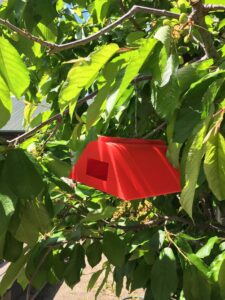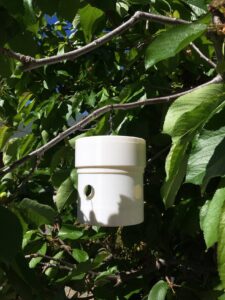Improved surveillance tools for key biosecurity targets (fruit flies, Gypsy moth)
This five-year project finished in mid-2022.
Project abstract
Many insects are common pests in horticulture, agriculture, and forestry sectors, posing biosecurity risks to trading countries worldwide. Efficient species-specific semiochemical lures are available for some of these pests, facilitating the implementation of post-border surveillance programmes via trapping networks. These networks have a long history of success in detecting incursions of invasive species; however, their reliance on manual trap inspections makes these post-border surveillance programmes expensive to run. Novel smart traps integrating sensor technology are being developed to detect insects automatically but are so far limited to expensive camera-based sensors or optoelectronics sensors for fast-moving insects.
For this project, we have developed an optoelectronic sensor that can fit in different types of traps to record wing-beat frequencies of flying insects and send remotely the digital detection via wireless communication for real-time biosecurity alerts.
Our laboratory and field trials have proven that insects flying in/out of the trap can be detected automatically and generally before visual trap catch, thus improving earlier detection while decreasing significantly the cost of labour by targeting biosecurity efforts only in the location of detection. These new smart traps, combined with machine learning algorithms, can further facilitate diagnostics via species identification through biometrics.
The deployment of such smart traps for biosecurity provides a sustainable low-carbon solution with faster and earlier detection of invasive pests.
Biosecurity outcome
- Better attractive lures targeting female QFF to improve detectability of a new incursion and support eradication attempts.
- Self-reporting low-power sensors for integration into FF and GM surveillance programmes. Traps will remotely communicate instantaneous insect catch to end-users reducing labour costs and enhancing early detection. Machine learning will allow for the automatic classification of the trapped species, reducing false alerts.
Science outcome
- Discovery of a new mix of behaviourally active compounds for attracting female QFF based on pheromone and/or kairomones (STOPPING in June 2020)
- Creation of a library of Wing Beat Frequency (WBF) signatures for biosecurity threats used as new diagnostic tool for species identification.
- Development of sensor technology in combination with the Internet of Things (IoT) for automatic data collection.
- Spatially and temporally precise data for wide-area remote monitoring contributing to more accurate models of population dynamics.
- Capability developed in data processing via machine learning for easier interpretation of complex data, easily communicable to the end-user.
For more information and publications from this and other B3 projects, visit Zotero.
The Zotero database is on the B3 homepage under ‘Outputs’.

‘Delta’ trap for moths

Lynfield trap for fruit flies
